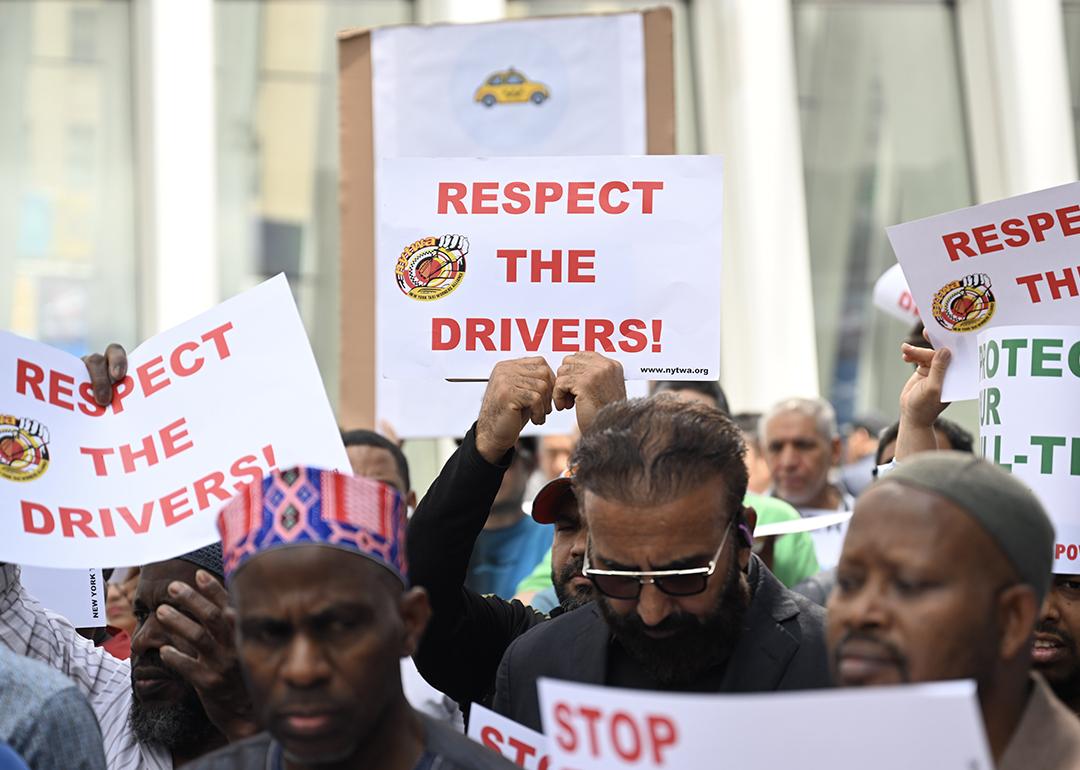
'Our pay has not kept pace': Rideshare driver discontent grows with rising insurance and maintenance costs
This story was produced by Insurify and reviewed and distributed by Stacker Media.
'Our pay has not kept pace': Rideshare driver discontent grows with rising insurance and maintenance costs
Rideshare drivers face some of the highest expenses among gig workers, and their costs are only increasing. Full-coverage car insurance rates skyrocketed by 24% in 2023 and are on track for a 7% increase this year. Car maintenance and repair costs surged by 36.2% between January 2019 and January 2024, according to the U.S. Bureau of Labor Statistics (BLS).
Pressure is mounting from drivers seeking higher wages and better working conditions. Thousands of drivers have participated in nationwide strikes in 2024, and Minneapolis passed a citywide pay ordinance raising the minimum compensation for rideshare drivers.
Insurify's data science team used its proprietary database to determine average rideshare car insurance rates and surveyed drivers to uncover the challenges of working for Uber and Lyft in 2024. Three drivers working in different markets also shared their experiences.
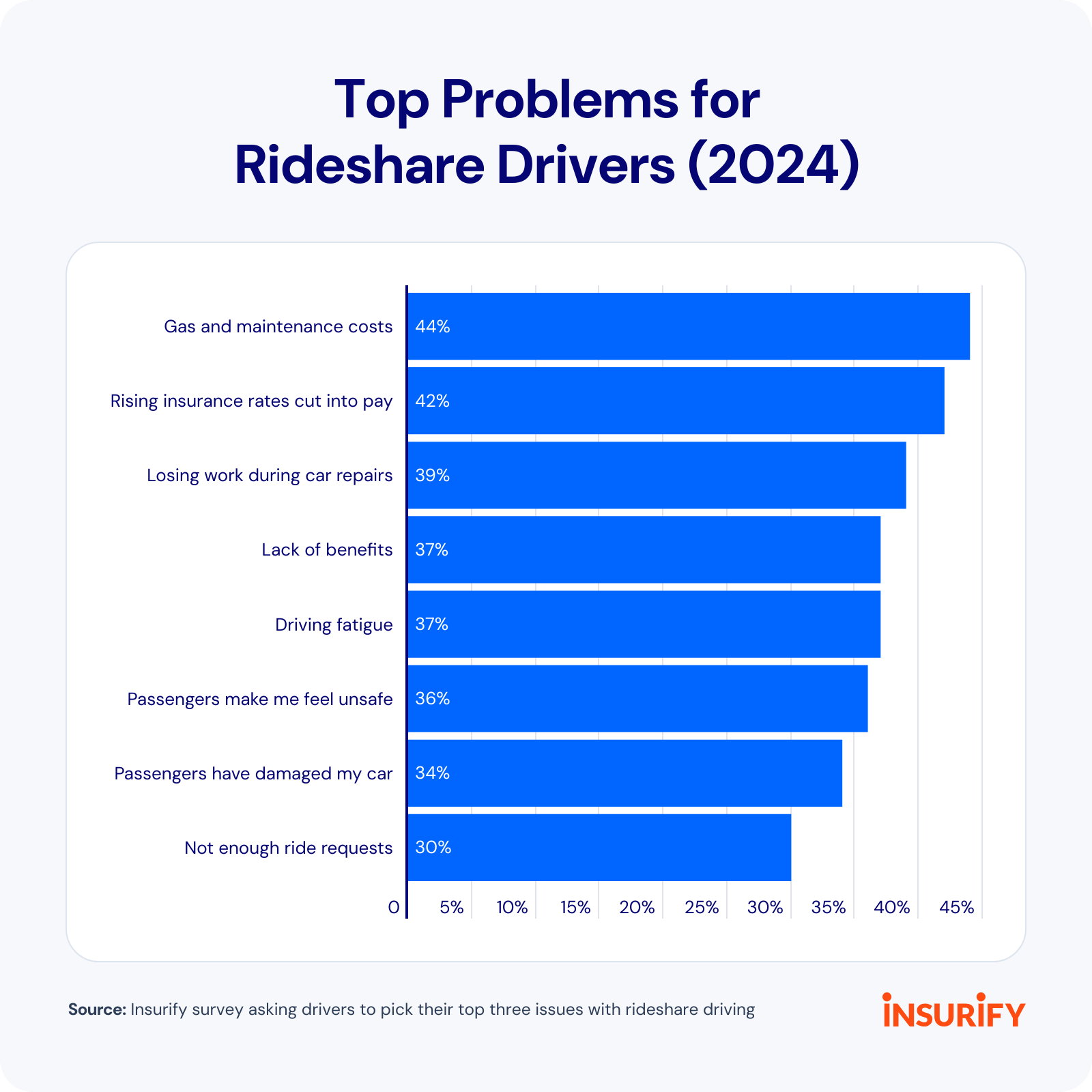
Key takeaways:
- Rideshare drivers pay an annual average of $2,859 for full-coverage insurance — $300 more than non-rideshare drivers, according to Insurify data.
- More than one-quarter (26%) of rideshare drivers in an Insurify survey said they don't disclose that they drive rideshare to their car insurance companies.
- Gas and maintenance costs cutting into earnings is the biggest problem rideshare drivers reported in an Insurify survey, with 44% ranking it in their top three issues. The rising cost of car insurance was the second-most important, affecting 42% of drivers.
- Vehicle maintenance and repair costs increased by 8.2% between March 2023 and March 2024, according to the Consumer Price Index for All Urban Consumers (CPI-U).
- The percentage of rideshare drivers comparing rates through Insurify nearly doubled during COVID-19 lockdowns, increasing from 0.7% of all applicants in 2020 to 1.3% in 2022.
- Male drivers far outnumber female drivers, accounting for 62% of the rideshare drivers in Insurify's database.
How much do rideshare drivers make? The answer is anything but straightforward
Transportation and warehousing industry workers earn an average of $30.55 per hour, or $1,173 weekly, as of March 2024, according to the BLS. Earnings have increased by 6% in the last year.
Figuring out exactly how much rideshare drivers make is more complicated. Gross earnings estimates from Gridwise break down to $24.05 per hour with Lyft and $24.30 per hour with Uber in 2023. ZipRecruiter estimates average hourly wages of $14.89 for Uber and $15.57 for Lyft drivers as of April 2024.
Uber drivers saw the sharpest year-over-year decline (-17.1%) in gig driver earnings between 2022 and 2023, according to the Gridwise Gig Mobility Report. The report analyzed data from millions of trips made by more than 500,000 drivers.
Uber's and Lyft's numbers are higher because the companies publicize driver earnings for engaged hours — $33 and $30.68, respectively. Engaged hours, also called active or utilized hours, include the time between accepting a trip and reaching the pickup destination, waiting for the passenger to enter the vehicle, and driving the rider to the drop-off destination.
To rideshare drivers, this measurement is "meaningless."
"Last time I checked, there were still 60 minutes in an hour. If my utilization rate is 50%, which is true for Los Angeles these days, that $32 is $16 before expenses," Sergio Avedian, rideshare driver and senior contributor at The Rideshare Guy, said.
When Avedian started driving in 2016, he earned around $60 per hour before expenses. Now, he earns between $21 and $22. Avedian noticed a change in his Uber earnings when the company went public in 2019, which he attributes to a shifting focus toward profitability. As his earnings have decreased, his expenses "have gone through the roof."
"Rideshare drivers are not immune to inflation. We're facing inflation as much as anybody. Our pay has not kept pace at all. In fact, it's gone the other way."
Lyft drivers' engaged hourly earnings have grown more than 18% since the second half of 2019, according to the company. Utilization rates over time aren't disclosed, but Lyft pledged to pay drivers at least 70% of its riders' fares in 2024.
Uber CEO Dara Khosrowshahi, on the other hand, said in a 2023 earnings call that Uber drivers' "high" earning levels "allow[ed] us to take incentives down."
Drivers struggle to turn a profit with Lyft Express Drive
Lyft's Express Drive program provides rental cars through Flexdrive and Hertz to rideshare drivers who don't own cars or don't want to put miles on their personal vehicles. Nicole, a 33-year-old Lyft driver from Seattle, Washington, says the program is "highly predatory."
"I think the only people who are really able to make a lot of money are the people who own their vehicles," said Nicole, who rents a Nissan Kicks through Lyft's Express Drive program for $285 per week. Nicole owns a RAV4, but it's too old to qualify for Lyft. "[Express Drive] basically makes you earn your money back before you can make any earnings."
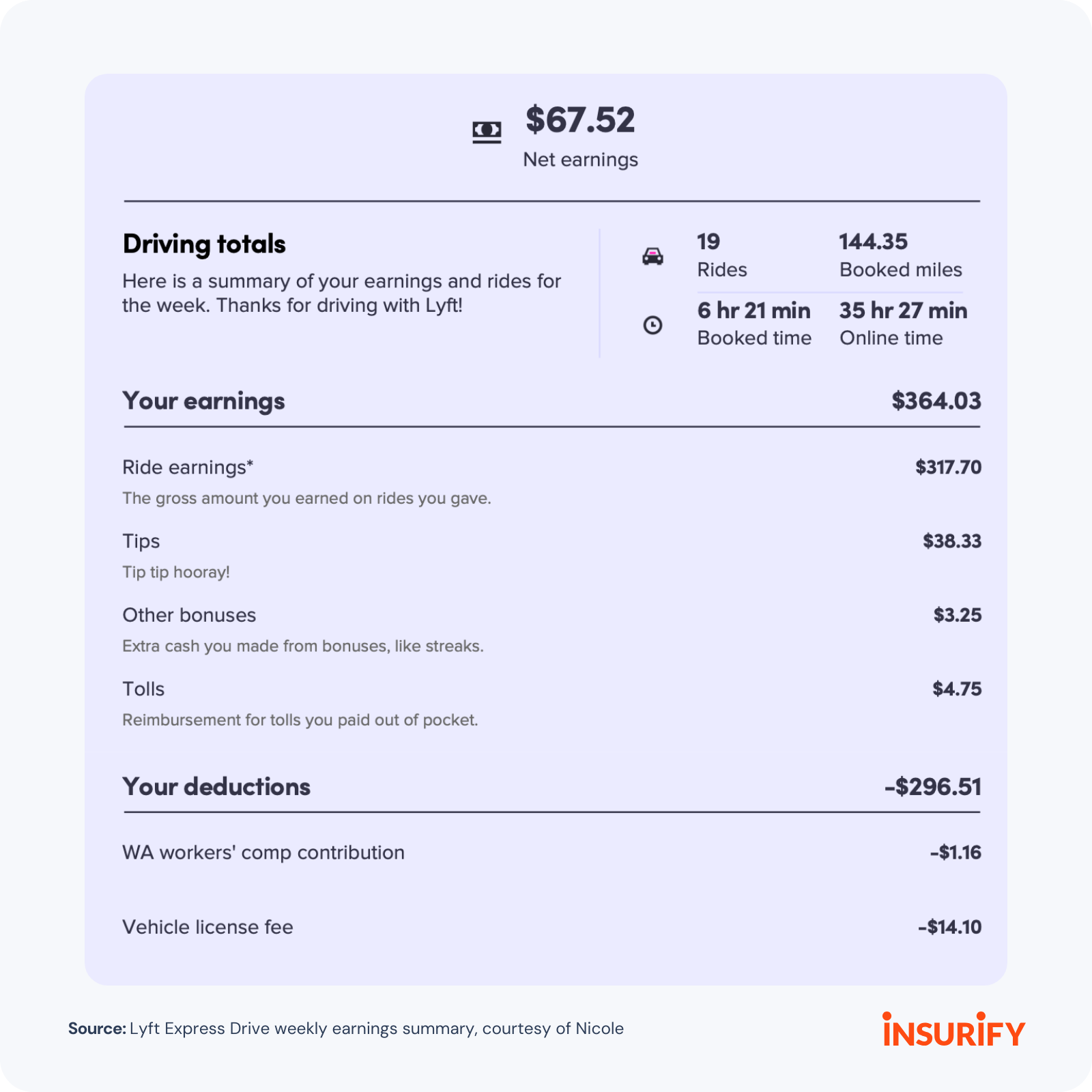
A losing proposition
Workers who rent through Flexdrive pay for any personal miles they drive when the Lyft app is off, and the price varies by market. Rates range from $220 for a weekly rental and unlimited personal miles to $420 per week for a rental and 200 miles, according to posts in the Reddit forum r/lyftdrivers. In Nicole's case, the base plan charges $20 for every 1 to 25 miles.
On top of rental cost deductions, Express Drive pays about 17% less than the standard rate, according to Lyft. "They actually deduct 44 cents per mile in Seattle," said Nicole, who also cited issues with finding enough rides to qualify for the program.
"In order to do the Express Drive program, you have to maintain 20 rides per week. … But it's hard to get to 20 rides because the market is just so saturated. I've literally spent 40 hours of online time, and I'd get six rides. Then, I'm stuck paying the fee for the rental, and I'm out the money."
Nicole owed Express Drive about $250 as of late March.
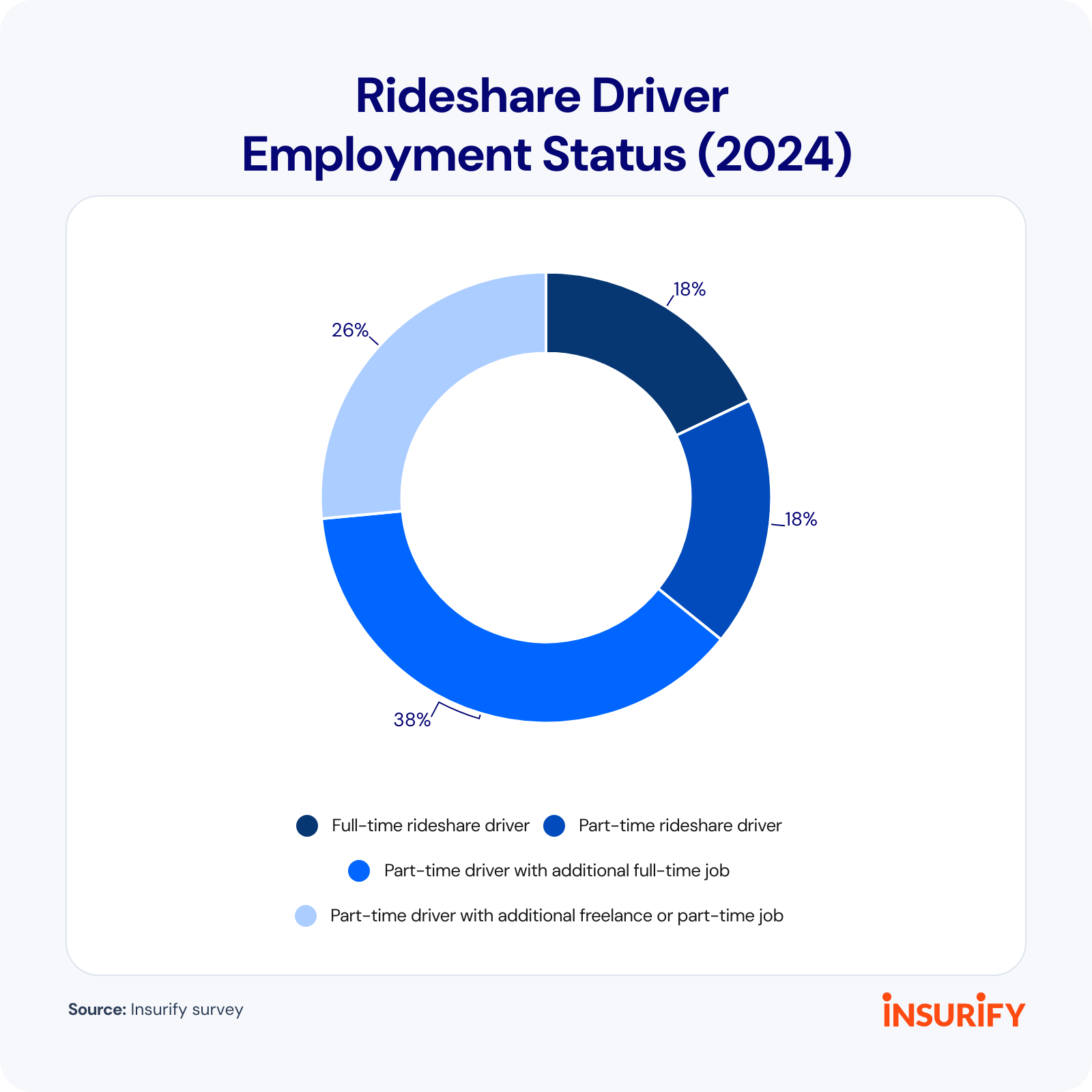
Less than 20% of rideshare drivers are full-timers
Only 18% of rideshare drivers rely on Uber or Lyft as their only source of full-time income, according to an Insurify survey. Thirty-eight percent drive for extra income on top of a full-time job, and another 26% have freelance or part-time jobs in addition to rideshare driving.
Heng, a 41-year-old data analyst from San Diego, California, started driving full-time for Lyft, Uber, and HopSkipDrive when he couldn't find the right job in his field. Heng starts his shift at 8 a.m. and ends at 4 p.m. on weekdays to pick up his two young children. On weekends, he starts driving earlier and works 12-hour days.
"It seems sustainable at the moment, just because all the pressure of being a sole provider is not on rideshare driving," says Heng, whose wife has a W-2 job with insurance. "There's less pressure on me to work [too many] hours, so I don't get burned out as much."
The biggest benefit of rideshare driving for Heng and his family is having a flexible schedule, though he's still looking for a data analyst role.
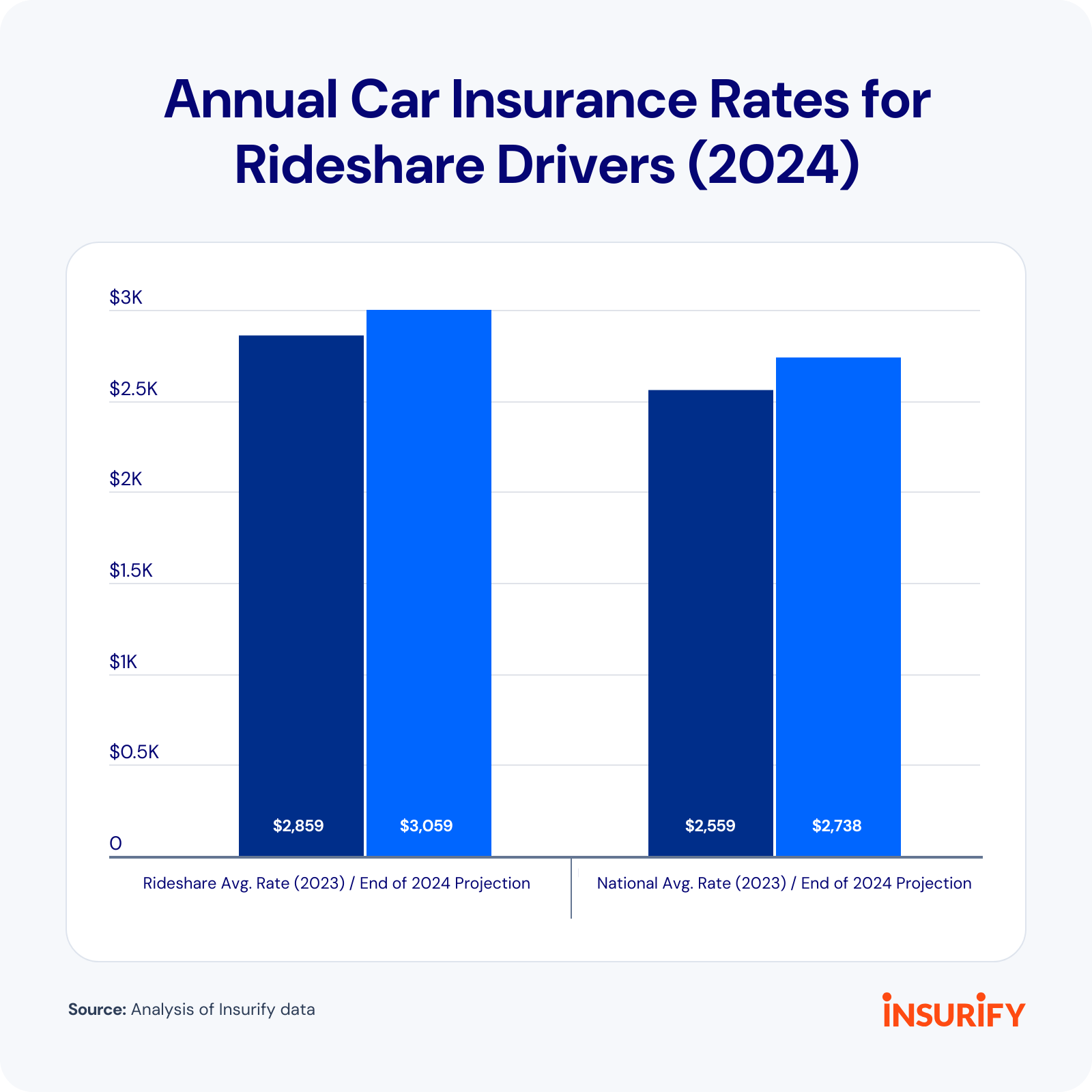
Rideshare drivers face 12% higher car insurance costs
Car insurance rates soared by 24% in 2023, and Insurify's data science team projects an additional 7% increase in 2024. Drivers across the board are facing premium increases, but rideshare drivers might feel it a bit more. At an average annual cost of $2,859 for a full-coverage policy, rideshare drivers pay 12% more for car insurance than non-rideshare drivers.
Nearly 42% of rideshare drivers surveyed by Insurify say that the increasing cost of car insurance, which cuts into their pay, is one of their top three problems with driving for Uber or Lyft. Rideshare drivers could see annual rates surpass $3,000 by the end of 2024, according to Insurify's projections.
Insurers factor in mileage when determining car insurance rates. Driving more miles increases the risk of car accidents, so high-mileage drivers usually have higher rates. Full-time rideshare drivers can easily rack up 1,000 miles a week, according to the rideshare information search engine RideGuru. The average American drives about 240 miles weekly.
Twenty-six percent of rideshare drivers in Insurify's survey said they don't report ridesharing to their car insurance companies. Drivers could face serious financial consequences if they don't disclose ridesharing.
If you don't report that type of usage to your insurance company, and they find out about it, your policy will likely be canceled due to unreported business use and improper rates. If you have an accident while rideshare driving or doing a delivery task, the coverage has a high probability of being denied.
Rideshare companies require drivers to carry the mandatory minimum car insurance, but standard auto insurance policies often exclude ridesharing coverage. Drivers can purchase rideshare insurance as a stand-alone policy or as an add-on to their personal insurance policies.
Uber and Lyft provide additional insurance coverage, but only when the app is on and a driver is accepting rides. Vehicle theft, vandalism, and accident damage to a rideshare driver's car aren't covered by either company if the driver doesn't have personal comprehensive or collision insurance.
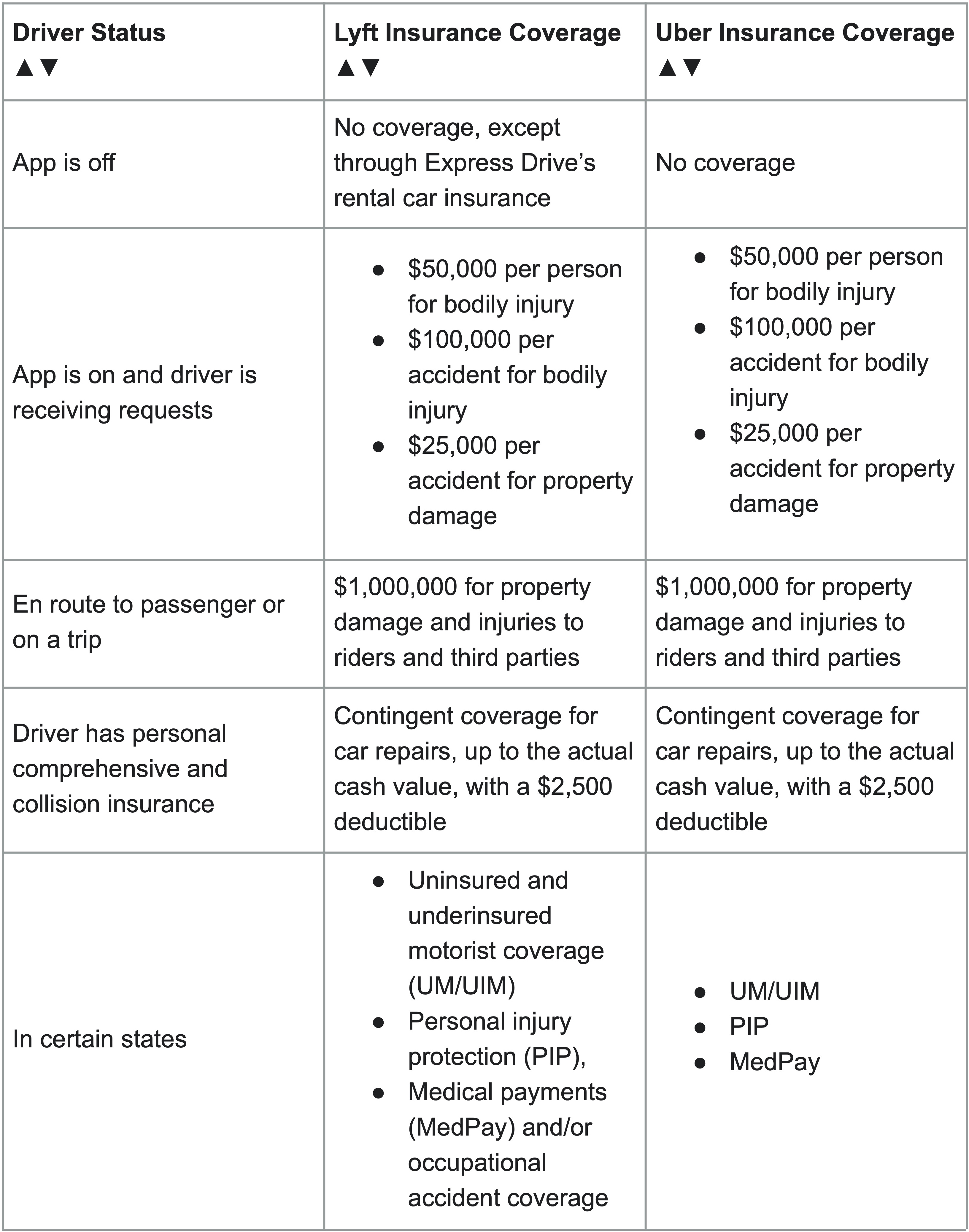
Rising maintenance costs cut into driver earnings
Gas and maintenance costs cutting into pay is the most significant issue rideshare drivers face, with 44% reporting it as one of their top three problems with driving in a 2024 Insurify survey.
As independent contractors, Lyft and Uber drivers are responsible for expenses, including gas, auto insurance, maintenance, car washes, and detailing. Car maintenance and repair costs have increased by 8.2% in the last year, according to the March 2024 CPI-U.
"As a rideshare driver, you should consider yourself a small business," says Heng. "You need to know how much you're making — and how much it costs to make that money — to know if you're profitable or not."
The average cost of owning and operating a new car — including depreciation, financing, fuel, insurance, license and registration, taxes, maintenance, repair, and tires — is $12,182 per year, a 2023 AAA report found. Maintenance, repair, and tires cost drivers an average of 9.83 cents per mile.
Heng tracks his earnings and expenses in color-coded Google Sheets, which he shares on his YouTube channel. He factors in regular costs, including gas, oil, and a car wash subscription, and startup costs, like a seat cover. Two months into rideshare driving, the method is working well for Heng, though he notes, "I haven't had any surprise expenses yet."
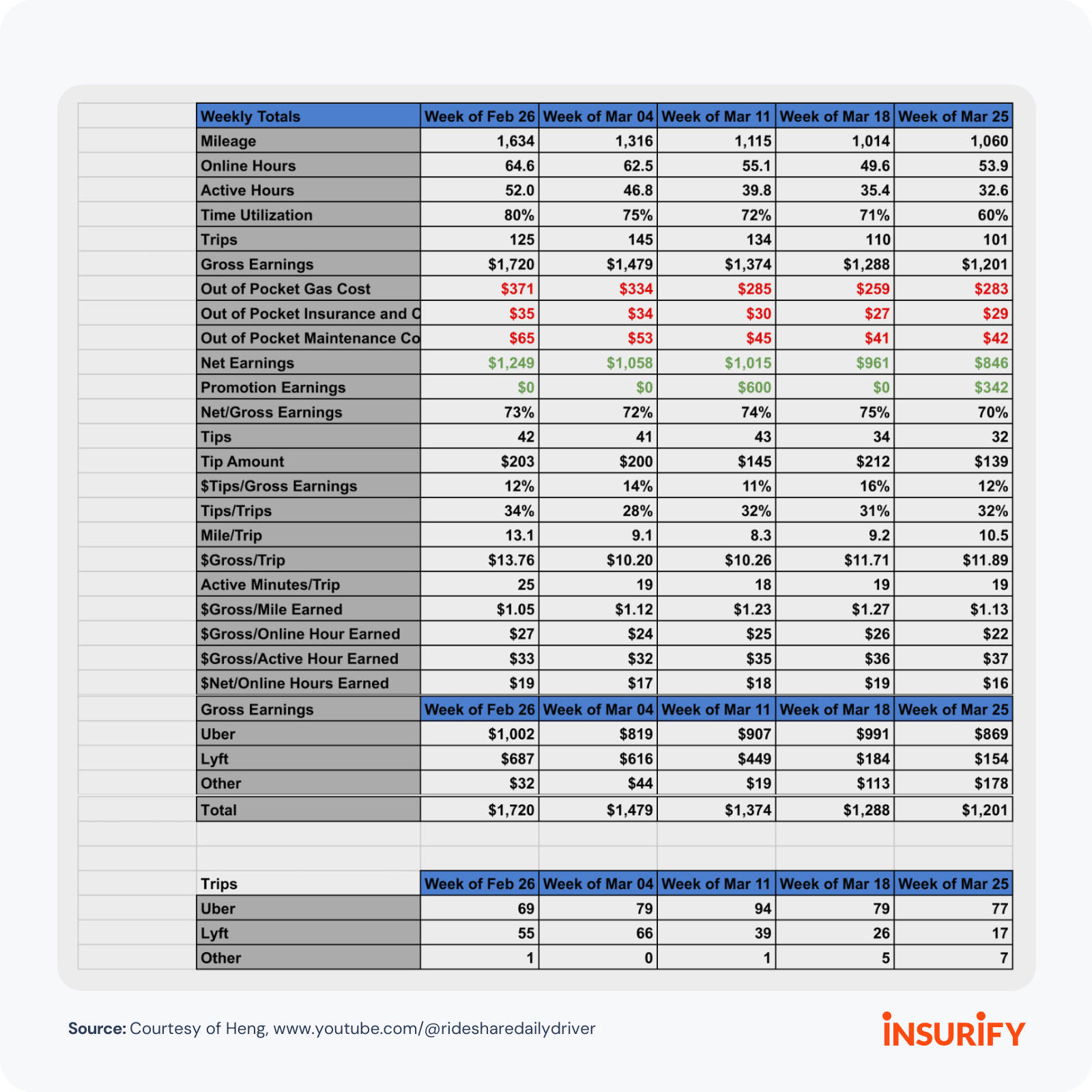
Tracking yields few surprises
Avedian, who regularly interviews drivers for The Rideshare Guy, says most people don't keep such detailed records.
"[Drivers] see $200 hit their bank accounts, and they think they've made $200. A year later, you have 60,000 miles on your car and a bad lower back, and all you did was use your car like an ATM machine, basically. You take the remaining equity in your car and trade it for short-term cash to pay your bills."
Unsafe passengers are a top issue for 36% of rideshare drivers
More than a third (36%) of rideshare drivers say passengers making them feel unsafe is one of their top three problems with the job, an Insurify survey found. Women (37%) and men (35%) reported safety concerns at similar rates, but the issues they commonly encounter differ.
"What's weird about Lyft is that [drivers] have our name displayed and a photo of ourselves. But they don't require the customers to have that, and a lot of the customers have fake names," said Nicole. "I've literally come across 'Face Sitter' — names like that with sexual tones. The unfortunate thing is, I would still take those rides because I needed to make the ride quota."
Avedian has also encountered fake customer names, including a 2 a.m. ride request from a passenger called "Killer." Avedian didn't find the name amusing.
At least 31 murders of app-based drivers occurred in 2022, according to a report by the advocacy group Gig Workers Rising. Christina Spicuzza, a 38-year-old mother of four, was among the Uber drivers murdered that year. Spicuzza's dashcam caught her passenger, Calvin Crew, holding a gun to her neck. The footage served as key evidence in the high-profile case.
Sixty-one-year-old Uber driver Loletha Hall's dashcam captured a similarly chilling event in April 2024. Eighty-one-year-old William Brock shot and killed Hall, who was unarmed and backing away, because he falsely thought she was trying to scam him. Authorities believe a third-party scammer sent the Uber courier request to Hall, asking her to pick up a package from Brock.
Violent passengers are a prevalent risk, with 67% of rideshare drivers experiencing some type of violence at work, according to a survey by the Strategic Organizing Center, a coalition of North American labor unions. Twenty-seven percent of rideshare drivers have been sexually propositioned, and 3% have been sexually assaulted or raped on the job.
Lyft launched Women+ Connect, a feature that matches women and nonbinary drivers with more women and nonbinary riders, in September 2023. But matching based on gender isn't always possible. Women comprise nearly half of all Lyft passengers but just 23% of drivers, according to the company.
Lyft also doesn't verify passenger identities, so men can easily sign up for Women+ Connect if they press a button and change their gender to woman or nonbinary in the app.
Nicole, who uses Women+ Connect, said she gets about a 50/50 split of male and female passengers. "I did have a passenger yesterday who said I was the first female driver she's had, even though she has Women+ Connect turned on, and she always takes a Lyft to and from her job. She gets off at 9 p.m. She said it's kind of scary because it's so late. It works when it works, but you're definitely not guaranteed a woman."
Avedian is similarly skeptical about Women+ Connect, calling it "a good PR thing," but noting the number of female drivers is already low and "during drunk hours, it drops down to single digits."
Like many female drivers, Nicole doesn't drive late at night. "I've heard from other Lyft drivers that they've picked a guy up from a bar. The guy won't get out of the car. They take the guy to his house, and he tries to get them to go into the house. … It's not worth it for my safety, but it'd be worth it for my pocketbook."
Rideshare drivers push back against poor pay
Rideshare drivers, along with the labor organizations Justice for App Workers and Rideshare Drivers United, organized multiple nationwide strikes in 2024. Their demands include higher wages and changes to working conditions, including an end to unjust profile deactivations.
Drivers across the U.S., including in New York, Chicago, Miami, and Philadelphia, participated in the May Day strike on May 1. Thousands of drivers also participated in a Valentine's Day strike, though the number of drivers protesting in each city was relatively low.
About 150 drivers stopped airport pickups and dropoffs in Philadelphia on Valentine's Day, but Uber has more than 2,500 drivers in the area, ABC reported.
"Because there's so much market saturation, even if 100 drivers strike, you still have a couple of thousand drivers out there looking for rides," says Nicole.
Many drivers believe market oversaturation has cut into their potential earnings. Not being able to find enough passengers was a top-three concern for 30% of the rideshare drivers Insurify surveyed.
Uber and Lyft saw an influx of new drivers as COVID-19 lockdowns caused mass layoffs in 2020. The percentage of insurance applicants driving rideshare nearly doubled between 2020 and 2022, according to Insurify's database. Uber, which doesn't publish driver numbers annually, had 2 million drivers in 2017. The number surged to 5.4 million in 2022.

Game changer in Minnesota
Putting pressure on legislators is more effective than striking, Avedian believes. "What's happening now in Minneapolis — that's going to change the game."
Uber and Lyft threatened to leave Minneapolis after the City Council passed a pay ordinance mandating that drivers must earn at least $1.40 per mile and 51 cents per minute. The ordinance took effect July 1, and negotiations between Uber, Lyft, and the Minneapolis legislature are ongoing.
An amendment to the ordinance proposed a compromise of $1.27 per mile and 49 cents per minute, but the rideshare companies are aiming for lower pay. Lyft is pushing for 89 cents per mile, spokesperson Eric Smith told Axios. Uber has declined to share target rates.
The companies are also looking for reassurance that Minnesota won't reclassify rideshare drivers as employees, who have more job protections than independent contractors, including the right to unionize.
Avedian advises drivers who want higher wages and better working conditions to "Find some friendly city councils and push."
'There is no gig economy' without rideshare drivers
In 2020, 68% of drivers were no longer active on Uber after six months, a Stanford University study found. Uber and Lyft don't release turnover data, but Khosrowshahi mentioned Uber's driver churn rate had decreased substantially in an August 2023 earnings call.
Nicole, who plans to quit Lyft Express Drive, says the program "just seems like some weird indentured servitude."
Heng, who drives his own vehicle, says he'll continue rideshare driving while he applies to data analyst roles. "The thing is, I haven't been driving for long. I started in February. … I can see, maybe in the future, it might get grindy. But you'll have to ask me later."
Some churn is likely due to the nature of the job. Rideshare gigs provide quick income to drivers who are between full-time roles, but low earnings factor into the turnover rate.
"I can't drive for $21 per hour before expenses. I just can't," says Avedian, who still picks up rides when offered incentives. "I don't care how many buttons you push [on your phone] as a consumer. … Somebody has to bring you the food. Somebody has to take you to the airport. Somebody has to pick your drunk butt up at a bar. Without drivers, there is no gig economy."
Methodology
Insurify's data science team analyzed its proprietary database of more than 97 million quotes to determine car insurance costs for rideshare drivers. Rates reflect the median cost for a driver between the ages of 20 and 70 with a clean driving record and average or better credit. Insurify also surveyed 385 rideshare drivers across the U.S. about wages and working conditions.
Insurify driver applications come from all 50 states and Washington, D.C. Applications include information on the coverage specifications of each driver's quoted policies. The premiums recorded on Insurify's comparison platform are real-time quotes from partnering insurance companies. Additional data is available via Insurify's Auto Insurance Data Center.



